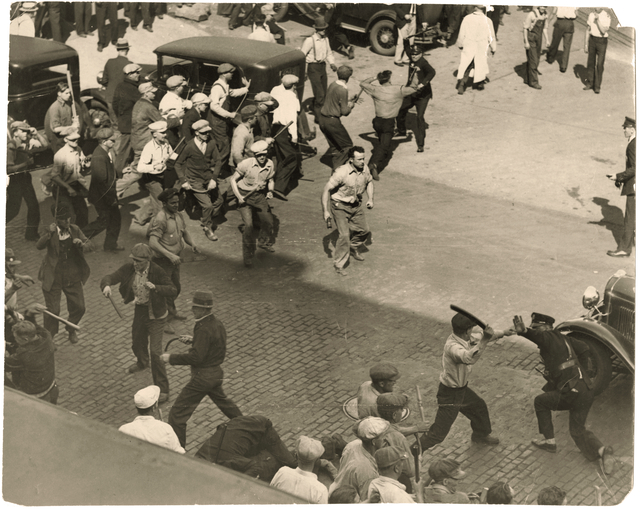“The Battle of Deputies Run” was fought 80 years ago in downtown Minneapolis, in the heart of what is now the fashionable North Loop. One of the bloodiest clashes in the history of the city, this armed skirmish grew out of the protracted Truckers’ Strike, which consumed Minneapolis during 1934. This conflict between the radical Teamsters’ Union and the powerful Citizens’ Alliance began in February and plunged the city into civil war for most of 1934. No one could remain neutral in the city, which was paralyzed by the strikers’ blockade and the violence between the picketers and the employers. The city’s ruling elite circled the wagons–raising a “citizens army” that battled strikers in the streets. But strikers garnered vast support from other workers, who made up the majority of the city.
After employers had refused to recognize the teamsters’ union, the city’s truckers voted to strike in the middle of May. Truckers refused to drive; they also organized to block any truck traffic in and out of the city. These “flying pickets,” ” had the town tied up tight,” the sheriff explained. “Not a truck could move in Minneapolis.”
By the fifth day of the strike, the city’s food supply was dwindling and both sides were growing impatient. The Citizens’ Alliance denounced the “Red Dictators” who were determined to “starve our city into submission.” They tried to break the strike by luring a group of picketers into an alley where they were beaten with saps and night clubs. But after dozens of protesters were hospitalized, strikers were galvanized. They prepared for armed conflict, organizing for battle in the city’s central market, the nexus of the city’s truck traffic and thus a critical site for both sides.
Strikers spent the next couple of days making clubs and building their reserves for battle. On the morning of May 21st, they marched in military formation from the Central Labor Union headquarters to the central market, where they faced armed police officers and employers who had been deputized. “Clubs, pipe, rock and in instance a knife were used by the crowd after police watched two truckloads of strikers enter the district and unload. ..Some hundred police armed with sawed-off shotguns…attempted to halt the advancing group.”
The battle between the strikers and the deputies was broadcast live by local radio station KSTP, which reported it like a football game. Listeners all over Minnesota followed the action blow by blow.
Strikers won this battle, which was one of many violent clashes in the city during the summer of 1934. The Teamsters were finally victorious in August, forcing employers to recognize their union and negotiate over wages and working conditions. Their success electrified labor organizers across the country. It also fundamentally changed the balance of power in the city, which had earned been known as an “Open Shop” town since the beginning of the twentieth century thanks to the Citizens’ Alliance, which was considered the most powerful employers’ group in the country.
Material for this post was taken from Charles Rumford Walker’s classic account of the Truckers’ strike, American City. Images are from the collection of the Minnesota Historical Society.
